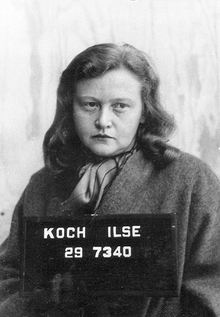Ilse Koch | |
|---|---|
 Koch, c. 1945 | |
| Born | Margarete Ilse Köhler 22 September 1906 Dresden, German Empire |
| Died | 1 September 1967 (aged 60) Aichach, West Germany |
| Cause of death | Suicide by hanging |
| Other names |
|
| Known for | Atrocities committed at Buchenwald Wife of camp commandant Karl-Otto Koch |
| Criminal status | Deceased |
| Spouse | |
| Children | 4 |
| Conviction(s) | U.S. Military War crimes (1947) West Germany Incitement to murder Incitement to attempted murder Incitement to infliction of grievous bodily harm (5 counts) Incitement to infliction of bodily harm (2 counts) |
| Criminal penalty | U.S. Military Life imprisonment; commuted to 4 years imprisonment (1947) West Germany Life imprisonment (1951) |
Ilse Koch (22 September 1906 – 1 September 1967) was a German war criminal who committed atrocities while her husband Karl-Otto Koch was commandant at Buchenwald. Though Ilse Koch had no official position in the Nazi state,[1] she became one of the most infamous Nazi figures at war's end and was referred to as the "Kommandeuse of Buchenwald".[2]
Because of the egregiousness of her alleged actions, including that she had selected tattooed prisoners for death in order to fashion lampshades and other items from their skins, her 1947 U.S. military commission court trial at Dachau received worldwide media attention, as did the testimony of survivors who ascribed sadistic and perverse acts of violence to Koch – giving rise to the image of her as "the concentration camp murderess".
However, the most serious of these allegations were found to be without proof in two different legal processes, one conducted by an American military commission court at Dachau in 1947,[3] and another by the West German Judiciary at Augsburg in 1950–1951.[4] Harold Kuhn and Richard Schneider, two U.S. Army lawyers tasked with conducting the official review of her conviction at Dachau, noted that "in spite of the extravagant statements made in the newspapers, the record contains little convincing evidence against the accused... In regard to the widely publicised charges that she ordered inmates killed for their tattooed skin, the record is especially silent".[5]
That the wild claims were dismissed as lacking evidence did little to sway public opinion. She was known as "The Witch of Buchenwald" (Die Hexe von Buchenwald) by the inmates because of her suspected cruelty and lasciviousness toward prisoners. She has been nicknamed "The Beast of Buchenwald",[6] the "Queen of Buchenwald",[7][8] the "Red Witch of Buchenwald",[9][10] "Butcher Widow",[11] and "The Bitch of Buchenwald".[12]
She died by suicide at Aichach women's prison[13] on 1 September 1967 at age 60.[14]
- ^ Jardim, Tomaz (2023). Ilse Koch on Trial: Making the 'Bitch of Buchenwald'. Cambridge, MA: Harvard University Press. p. 1. ISBN 9780674249189.
- ^ Przyrembel, A. (1 October 2001). "Transfixed by an Image: Ilse Koch, the 'Kommandeuse of Buchenwald'. | German History | EBSCOhost". openurl.ebsco.com. Retrieved 18 September 2024.
- ^ Simic, Olivera (5 September 2023). "'No woman in the usual sense': Ilse Koch, the 'Bitch of Buchenwald', was a Holocaust war criminal – but was she also an easy target?". The Conversation. Retrieved 18 September 2024.
- ^ Cite error: The named reference
:2was invoked but never defined (see the help page). - ^ Cite error: The named reference
:0was invoked but never defined (see the help page). - ^ Alban, Dan (10 November 2005). "Books Bound in Human Skin; Lampshade Myth?". Harvard Law Record. Retrieved 22 September 2008.
- ^ Boyle, Hal (14 August 1947). "Cruel 'Queen of Buchenwald' given a permanent address". The Milwaukee Journal. p. 2. Retrieved 16 December 2012.
- ^ "Buchenwald Queen must face German court on release". The Evening Independent. 4 July 1949. p. 15. Retrieved 16 December 2012.
- ^ "Ilse Koch, Red Witch of Buchenwald, on Trial". Los Angeles Times. 28 November 1950. p. 5. Archived from the original on 6 November 2012. Retrieved 16 December 2012.(subscription required)
- ^ "Life sentence for 'Red Witch' of Buchenwald". Lewiston Evening Journal. 15 January 1951. p. 6. Retrieved 16 December 2012.
- ^ "Army seeks new charges against butcher widow". The Evening Independent. 29 September 1948. p. 3. Retrieved 16 December 2012.
- ^ Shirer, William L. (1990) [1959]. The Rise and Fall of the Third Reich (3rd ed.). New York City: Simon & Schuster. pp. 983–4. ISBN 0-671-72868-7.
- ^ Cite error: The named reference
:3was invoked but never defined (see the help page). - ^ Cite error: The named reference
Hackett43was invoked but never defined (see the help page).